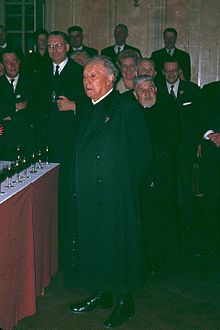Félix Kir
- View a machine-translated version of the French article.
- Machine translation, like DeepL or Google Translate, is a useful starting point for translations, but translators must revise errors as necessary and confirm that the translation is accurate, rather than simply copy-pasting machine-translated text into the English Wikipedia.
- Do not translate text that appears unreliable or low-quality. If possible, verify the text with references provided in the foreign-language article.
- You must provide copyright attribution in the edit summary accompanying your translation by providing an interlanguage link to the source of your translation. A model attribution edit summary is
Content in this edit is translated from the existing French Wikipedia article at [[:fr:Félix Kir]]; see its history for attribution. - You may also add the template
{{Translated|fr|Félix Kir}}to the talk page. - For more guidance, see Wikipedia:Translation.


Canon Félix Kir (22 January 1876 - 26 April 1968) was a French Catholic priest, resistance fighter and politician.
Life
He was born at Alise-Sainte-Reine on the Côte-d'Or. He entered a small seminary at Plombières-lès-Dijon in 1891 and was ordained in 1901. He then worked as a parish priest.
During the occupation of France during World War II, he took an active part in the French Resistance, helping with the escape of 5,000 prisoners of war from a camp at Longvic. He was arrested and condemned to death, but he was released because of his status. He continued organising operations and was seriously wounded, but escaped interrogation by the Gestapo.
In 1945, he was made a knight of the Légion d'honneur and was elected to the position of mayor of Dijon and to the French National Assembly. He remained the mayor of Dijon up to his death in 1968.
Legacy
A local drink, then locally known as blanc-cassis, consists of white burgundy wine, traditionally Aligoté, mixed with crème de cassis, a sweet, blackcurrant-flavoured liqueur. Kir habitually served this local drink to delegations, and so the drink itself is now known internationally as a Kir.[1][2][3] Alternately, some contend that German soldiers confiscated most of the region's red wine, so Kir converted a local brew of red wine and crème de cassis into a combination of white wine and crème de cassis, thus creating the drink.[4]
An artificial lake built to the west of Dijon was named Lac Kir in his honour. (47°19′40″N 4°59′56″E / 47.32778°N 4.99889°E / 47.32778; 4.99889)
References
- ^ Dale DeGroff, The Essential Cocktail: The Art of Mixing Perfect Drinks (Random House Digital, Inc., 2008).
- ^ "Sherry-Lehmann Reports on the Apéritif Hour," New York Magazine, Oct 23, 1972. Vol. 5, No. 43, p.45.
- ^ A. J. Rathbun, Wine Cocktails: 50 Stylish Sippers That Show Off Your Reds, Whites, and Roses (Houghton Mifflin Harcourt, 2009).
- ^ "The Kir Cocktail Is Cool Again". The Wall Street Journal. Archived from the original on 2023-05-29.
Further reading
- Butler-Gallie, Rev Fergus (2019). Priests de la Resistance: The Loose Canons Who Fought Fascism in the Twentieth Century. Oneworld.
External links
 Media related to Félix Kir at Wikimedia Commons
Media related to Félix Kir at Wikimedia Commons
- v
- t
- e
This article about a mayor in France is a stub. You can help Wikipedia by expanding it. |
- v
- t
- e
 | This article about a French Catholic cleric is a stub. You can help Wikipedia by expanding it. |
- v
- t
- e











